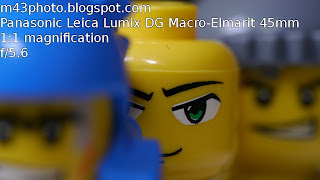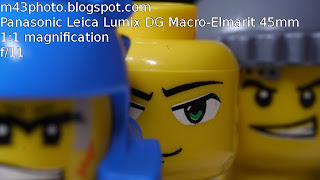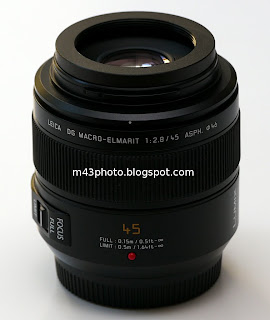
As a macro lens, the Leica Lumix 45mm f/2.8 is pretty ordinary. The max aperture f/2.8 is completely adequate for a macro lens, in fact, you would usually want to stop down to at least f/5.6 when taking close up pictures. Closing down for macro images is a necessity to achieve some depth of focus.
However, I think a lot of people also anticipated to use this lens as a portrait lens. Being the only prime lens available for the Micro Four Thirds format with a typical portrait focal length, there are not any alternatives at the moment. And I think some would find the max aperture of f/2.8 to be too small for portrait use. High end portrait lenses typically come with a max aperture of f/1.4, which is two stops larger than f/2.8.
Size
One of the prime advantages of the lens is the size. It is very small for a macro lens. The plastic construction, which, by the way, does not feel cheap, makes it light and easy to handle.
The lens does not extend when focusing, which makes it quite solid, and it is probably more weather resistant for that reason. It is not marketed as a weather resistant lens, though, so don't expose it to water if you can avoid it. The focusing is entirely internal, neither the front nor rear elements move during focus operation.
The size is roughly the same as the Panasonic Lumix 14-45mm kit lens when not extended.
Autofocus
The autofocus speed is very fast for typical portrait distances. It is also virtually inaudible. The precision of the autofocus is very good, as you would expect with a contrast detection autofocus (CDAF) system. Back focus and front focus are not issues with this system.
Here is an illustration video showing the Panasonic GH2 focusing the lens from infinity down to 45cm distance in 0.6 seconds. This was done in dull, indoor lightning. In daylight, the focus time is usually even faster.
When using the autofocus for close up focus distances, it does not function perfectly. At close to the magnification limit, you will some times experience false positives. The camera reports that focus is achieved, while nothing in the frame is in focus. This also happens sometimes with the Lumix 20mm f/1.7 pancake at close distances, by the way.
Some times, for example when photographing flowers, the camera will focus on the background, and not see the foreground flower at all, even if it covers the whole focus point. In this case, I've found that it helps to temporarily switch to manual focus (MF), manually choose the largest magnification, and then switch back to AF.
You can experience some focus hunting at close distances also. But mostly, the autofocus experience is favorable even at close distances.
Manual focus
Manually focusing the lens works in the same way as for the Olympus 50mm f/2 Four Thirds lens. The focus ring works in the same way, but has a different feel. On the Olympus 50mm f/2 lens, the focus ring runs very easily, but has a distinct click feel. You can feel when the angle sensor is triggered, and the lens makes discrete moves back or forth.
On the Leica Lumix 45mm lens, the focus ring is more dampened, and runs slightly less easily. You cannot feel the click stops in the same way. I would say that the Leica Lumix has a higher quality feel, but from a functional point of view they are equally good.
Sharpness
The lens is sufficiently sharp in the centre at f/2.8. I have not been unsatisfied with the centre sharpness. This is not a lens where you would expect good corner sharpness at max aperture, and closing down a bit will yield good results where corner sharpness is needed.
I have compared the sharpness with the Olympus Zuiko 50mm f/2 macro Four Thirds lens, and found that the Panasonic 45mm has slightly better sharpness for closeups images.
Bokeh
There is some ringing around the highlights. You could experience this, e.g., when having back lit foliage in the background in a portrait photo setup. Other than that, I've found the bokeh to be quite nice.
I've made four studies of the bokeh for this lens:
- Bokeh comparison between a number of fast lenses
- a comparison of the bokeh at various apertures for the Panasonic 45mm f/2.8 macro lens
- a bokeh comparison with the Olympus 50mm f/2 macro (Four Thirds format lens)
- a comparison with the Panasonic Lumix 45-200mm and 14-140mm zoom lenses
Macro
As a macro lens, the performance is quite impressive. It is capable of 1:1 macro reproduction. This is sometimes also written as "1×", and means that the lens is capable of focusing on something which is the same size as the sensor, i.e., 17.3×13.0 mm.
A full frame macro lens specified as 1:1, on the other hand, can be used to photograph something which is the same size as a traditional 35mm negative frame, i.e., 36×24 mm. As you can see, the Leica Lumix 45mm can focus on smaller objects, with about half the diameter.
Assuming you use this lens on a camera with 12 megapixels, this means that the number of pixels per 1mm length in the subject is 231. For comparison, let's say you use some premium full frame equipment, the Canon EOS 5D Mark III camera and the Canon EF 100mm F2.8 L IS USM Macro lens. At the closest maginification, this combination gives you 156 pixels per 1mm length in the subject photographed.
This means that you can take higher resolution photos of small items with the Leica Lumix 45mm, as compared with the Canon setup.
Here is a series of example images taken at 1:1 magnification. The focus distance is about 15cm, measured from the sensor. The distance from the lens front to the subject is about 6cm. I focused on the head in the centre.
The distance between the heads is one LEGO unit, or 8mm, for those who are not familiar with this measure. Even at f/22, the heads in front of and to the rear of the centre head are not in focus.

f/2.8

f/4

f/5.6

f/11

f/22
Note that when using small apertures like f/22, you will get some negative effect from diffraction.
Hood
There is a hood supplied in the box, and I have to say it's the most hideous hood I have ever seen. It looks stylish in a retro-Leica-way, but the functionality is poor. The hood can not be reversed on the lens for storage. It is much wider than needed. This is a short tele lens, while the hood could have been used on a medium wide angle lens. Hence the hood is not as efficient to keep out unwanted light. The hood is pictured on the lens below:

The lens is fairly suspectible to flare, so using a hood is advisable. Rather than using the supplied hood, you can get a third party tele hood designed for screwing into the 46mm front threads. What I chose, was to get a black 46-37mm step down ring, and use that as a hood. It may look odd, but in fact it protects the lens from flare better than the supplied hood. You'll also need a 37mm lens cap.
Getting both should set you back around US$10 on various auction sites. Here it is pictured:

To get even better protection against flare, you can put a 37mm stand off ring into the 46mm-37mm step down ring. There is still no vignetting due to the step down ring and stand off ring being used as hood. Attaching both looks like this:

Compared with the Olympus 50mm f/2 macro
It is natural to compare this lens with the Four Thirds format Olympus Zuiko Digital 50mm f/2 1:2 macro lens. Sizewise, the Leica Lumix 45mm is the smaller lens, but not by much. You can see the Leica Lumix to the left in the picture below. The Olympus 50mm was pictured with the adapter needed to use the lens on Micro Four Thirds cameras.

The Olympus lens is better suited as a portrait lens, given it's one stop larger aperture. On the other hand, the Leica Lumix 45mm has optical image stabilization, which to some degree makes up for the smaller max aperture. Whether you would prefer a larger max aperture or OIS depends on the situation.
The Lumix Leica will focus much faster on Micro Four Thirds cameras, which is a huge advantage. The Olympus 50mm is not optimised for CDAF, and will not autofocus at all with the Panasonic Lumix G1, GH1 and GF1 cameras. With other cameras, it will autofocus, but very slowly.
The Olympus 50mm f/2 1:2 macro is a very sharp lens. It is probably sharper than the Leica Lumix 45mm f/2.8 macro. On the other hand, the Olympus 50mm has somewhat harder highlight edges on the bokeh, while the Lumix Leica 45mm has smoother bokeh blur.
In terms of macro use, the Lumix Leica 45mm has the edge, achieving 1:1 macro. The Olympus 50mm f/2 is only capable of 1:2 macro, meaning it can take a close up picture of an object with twice the diagonal as the Lumix Leica 45mm.
The Leica Lumix 45mm has extra lens groups to handle the Optical Image Stabilization, and hence has a more complicated construction. It has a construction of 14 lenses in 10 groups, while the Olympus 50mm on the other hand has 11 lenses in 10 groups.

Conclusion This is certainly a good lens. Macro users will find it easy and fun to use. The compact size is a big advantage. The max aperture is a bit disappointing for portrait use, but if you mind the background a bit, it is no problem. It comes at an expensive price, though, which is probably at least partially due to the premium Leica branding.
Example image This image was taken using a cheap macro soft box, and a Panasonic Lumix DMW-FL360 TTL flash placed on the outside of the softbox. The exposure parameters are: ISO 100, f/5.6, 1/80 second. The image was scaled down and then sharpened.

Here is a picture showing the setup used to capture the image. The camera is placed on a tripod pointing into the bucked, while the TTL flash lies on the outside of the bucket.

Example video
Here is an example video, recorded at f/2.8. I had autofocus turned on, but in retrospect, it would probably have been better to leave it off, as it doesn't really do anything good.
Thanks for another nice article!
ReplyDeleteGreat work, and nice job with the bokeh comparisons. The PL45 is one of my favorite lenses.
ReplyDeleteOne more thing, the suggestion with the lens hood is really nice (and space-saving). Shame that the lens hood supplies doesn't fully deliver.
ReplyDeletePlease, can you do a comparison with the Zuiko 50mm f2 macro about bokeh and sharpness?
ReplyDeletei don´t find this in all internet.
thanks
Sorry, I can't do that. However, DPREVIEW.COM has reviewed both, including sharpness tests. So look there for a comparison.
ReplyDeletethanks, but i prefer "real" review like yours,
ReplyDeletewith examples and direct comparision.
Ok, I see what you mean. Initially, I though you were asking for a technical sharpness test, with MTF diagrams and so on.
ReplyDeleteI think your suggestion makes good sense. I will try to publish a comparison within around a week. It will be published like a new blog entry, not as changes to this article. So it should be easy to find.
One problem with this lens: I wasn't able to find a suitable ring flash for it.
ReplyDeleteHas anyone found a suitable ring flash or any other solution?
The non functioning supplied lens hood puzzles me. You pay premium for this lens, so a decent lens hood is the least you can expect from Panasonic. The supplied one is not deep enough and it's too wide for a short tele. Maybe it's designed like this to prevent blocking all light or hitting the subject at macro distances? For non macro use, a deeper round screw in lens hood probably will be better. You can sometimes find older metal lens hoods from Japan on eBay. Or (if you own it) you can use the one that comes with the Panasonic 25mm f/1.4.
ReplyDeleteOptically, the 45mm f/2.8 is a little disappointing I think. Especially because it's so darn expensive. Sharpness is good, but not great. Autofocus is a tad slower then the Olympus 45mm f/1.8 (using the limiter switch) and the f/2.8 aperture is not particularly fast. Build quality is fine and of course it has true 1:1 macro capability. However, it just doesn't seem to be the best lens for the money. Since there are no real alternatives, we're stuck with this thing for now. I hear that Olympus has a nice 60mm f/2.8 macro in the making, so I'm curious to see if it will better this Panasonic offering.
Anonymous,
DeleteYour hunch is right! Olympus does have a nice 60mm f/2.8 macro, and I hear it's incredibly sharp (and westher-resistant)! It should be awesome with the Olympus OM-D.
Does this lens performs better if I were to use it with a Macro Extension Tube set?
ReplyDeleteThank you
I would say not really. Currently, there is no macro extension tube set which carries the electrical signals between the lens and camera. Hence, you cannot use the focus or change aperture if the lens is mounted on an extension tube. This makes the lens very awkward to use.
DeleteAlso, the lens is capable of 1:1 magnification, which is very good. I don't see the need for even more magnification, for normal "amateur" use.
Even closer magnification requires much attention to details, like fine tuning of focus distance, specialized macro flashes, and so on.
you can force closed the iris of a native micro 43 lens lire the 45 1.8 in Aperture priority then press Dof preview , press the button and remore the lens,it email closed thai you can fit to cheap extension tube
ReplyDeleteI ordered this lens from Amazon and when I received it ...right out of the box it had a rattle noise when gently shaken. I sent it back due to others saying it was probably defective. I reordered it from B&H and this one too has a rattle. I read some blogs stating this may be normal due to the internal mechanisms of the lens. Any advice?
ReplyDeleteI ordered this lens from Amazon and when I received it ...right out of the box it had a rattle noise when gently shaken. I sent it back due to others saying it was probably defective. I reordered it from B&H and this one too has a rattle. I read some blogs stating this may be normal due to the internal mechanisms of the lens. Any advice?
ReplyDelete